30 December 2023
How to develop a sales organization structure
The aim is to optimize the sales organization structure to deliver the highest sales productivity with the least cost. Structure comes from the division of duties (tasks) allocated to specialist roles.
The extent to which you can specialize sales roles is limited by the organization size.
However, understanding the individual roles required to drive your sales model sets-up your organization to scale for growth – even if initially some roles need to be combined.
The crucial factor is defining the organization based on what selling tasks need to be done and not based around the skills and/or preferences of the existing people.
The approach advocated in this article is based on first defining your selling model and then listing the typical sales tasks that need to be routinely performed.
The following schematic describes the methodology discussed…
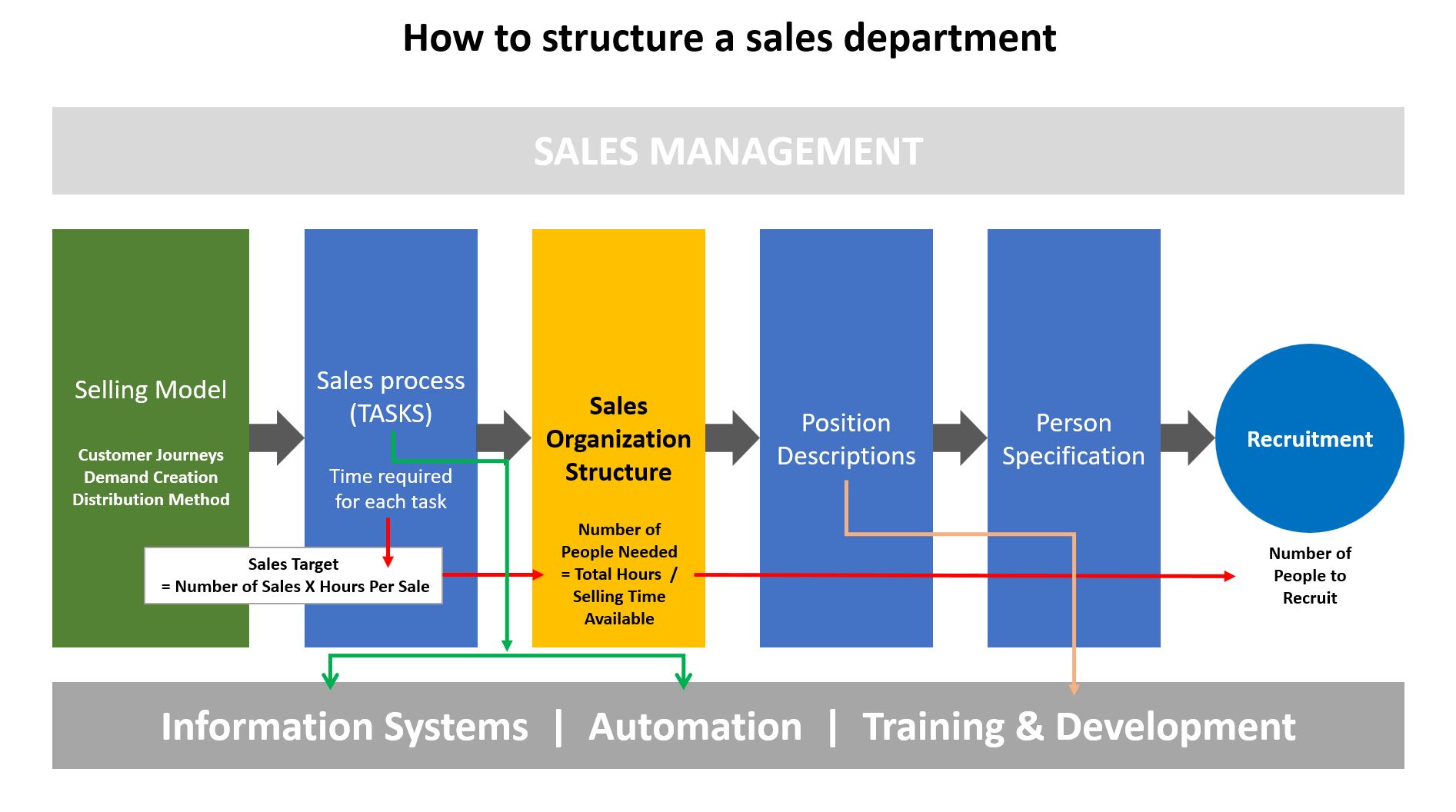
Selling Model
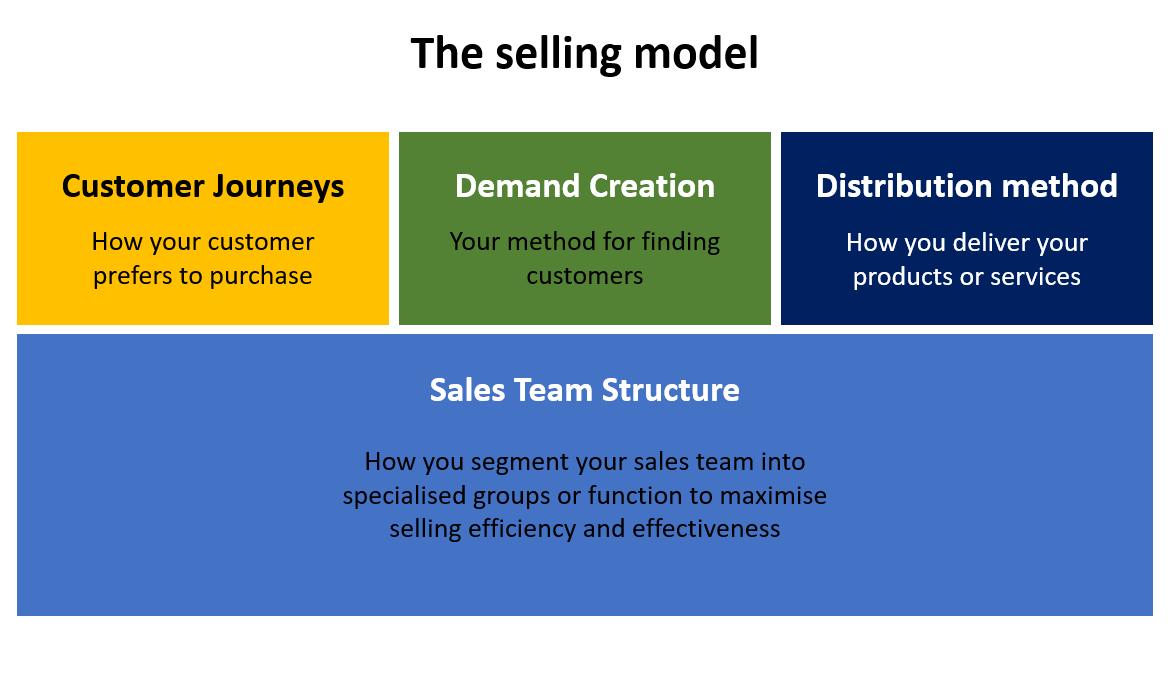
The selling model (or sales model) defines how you structure your sales efforts to achieve maximum efficiency and effectiveness and aligns with how your customer wants to purchase, your distribution model, and your demand creation method.
The Selling Model aims to harmonize marketing strategy/activities and sales strategy/activities so that both pull together as a team to generate revenue. It answers practical questions like "what makes the phone ring?", "who answers the phone?", "who writes-up the proposals?", or even "do we sell direct or should we appoint distributors?"
The key components of the Selling Model are:
-
Customer journeys: how do customers prefer to buy? For example do they expect to find your products near their home, happy to shop online, or expect a sales representative to visit them so they can better define their needs? How long is the sales cycle - minutes, days, months, or years? What is their process for researching options, brands, vendors, obtain pricing, make a decision and transact the sale? Understanding customer journeys informs shaping the selling model.
-
Demand creation method: Demand creation is achieved by promoting products/services to build the brand and generate enquiry. What makes customers want your products or services? Firstly sufficient numbers of them must know that you exist and secondly they need to perceive your value proposition to be superior to your competitors'.
Broadly, demand creation ranges from INBOUND marketing to OUTBOUND marketing. As the names suggest, outbound marketing is when a firm goes looking for customers (you found them) using a sales team or lead generation advertising. Whereas inbound marketing is mostly using online content marketing techniques to generate enquiry (they found you). Many firms use a mixture of both.
An inbound selling model requires more focus on a customer service team (inside sales reps) while outbound marketing requires more focus on an external sales team (outside reps or field sales people). -
Distribution: Firms either sell direct to end-user customers (direct distribution) or sell using intermediaries (wholesalers, retailers, agents, dealers, franchisees, system integrators etc.) Some firms sell both direct and through intermediaries (split distribution). These different distribution methods (often referred to as sales channels) require different types of sales team specialists thus the distribution method also shapes the structure of the sales department.
-
Sales force structure: While part of the selling model, before deciding the sales team structure, it is helpful to define the sales processes.
For a more detailed explanation see what is a sales model?
Sales process
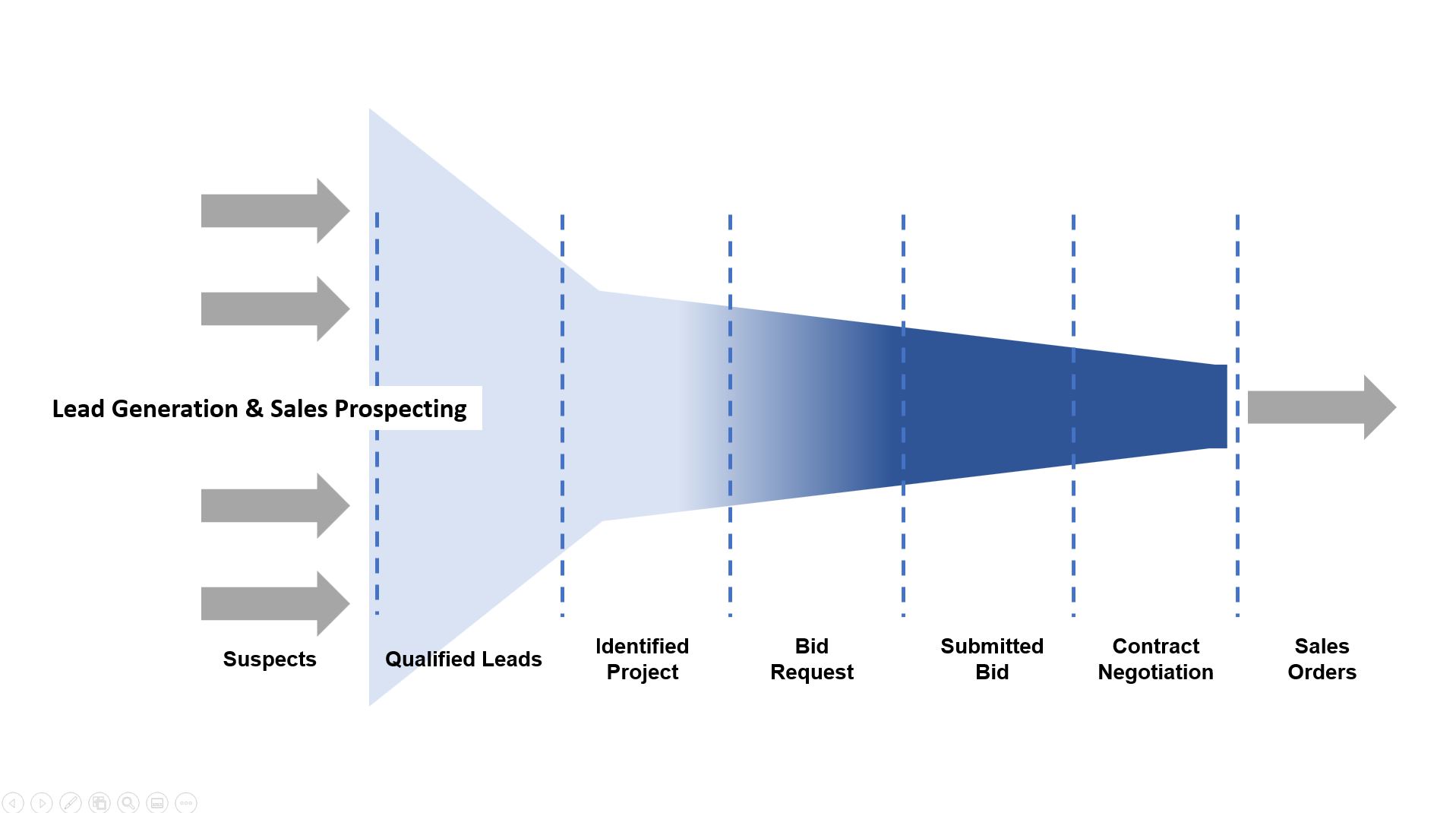
Every sales journey (from initial enquiry to closed sale) proceeds through distinct stages and requires performing particular sales tasks. Longer sales cycles (typical of high value sales transactions) are complex requiring more specialized sales tasks and overall far more total sales hours invested to achieve an outcome (win/lose/or discontinue).
While every sale can progress differently, and require more or less total sales hours, there will be commonalities to the process and an average number of hours needed.
For example, for project work, the anatomy of every sale will consist of...
-
Stages: each sale will likely progress through: Initial enquiry, capture planning, detailed bid evaluation, solution development, costing, proposal writing, bid submission, contract negotiation, sales closing, as-sold package.
-
Tasks: each of the above stages can be further broken down into distinct tasks. Included in these tasks will be client liaison, supervision and project management. The performance of these tasks is what consumes selling time which is performed by members of the sales team.
However, the sales process varies with:
-
Industry: Different industries may need sales people to perform specialized tasks particularly industries with complex compliance requirements.
-
Product or service type: The key differentiator here is the degree to which the product or service is customized. Products sold off-the-shelf "as-is" require less processes than those that require some customization or are entirely bespoke. Further, technical products may need product specialists within the sales team who provide technical advice to customers on how to select, use, and apply the products. Industry education aimed at people who design systems may also be a necessary sales function (specification selling).
-
Hunting or farming: For project selling (typically construction industry) the sales team are predominately hunting for the next project. Where there is the opportunity for future repeat business, a large part of the sales team is focused on servicing existing customers (account management). The primary selling focus is "farming" (farming existing accounts). Account management has its own set of distinct stages and tasks.
-
Transaction sales versus high-touch sales: Sales processes also vary between transaction sales (low-value, high-volume, fast processing) and "high-touch" sales which are high-value, low-volume, and have extended sales cycles (time between initial enquiry and outcome). Transaction sales typically require a team of "order-takers" who write-up the sales and push them through for processing (order fulfillment and invoicing). High-touch sales require skilled sales representatives to consult with customers to determine needs, develop a solution, and then writing-up a customized proposal. Different tasks. Different skill sets.
-
Distribution strategy: Businesses can sell direct or via intermediaries (see indirect distribution). Managing relationships with intermediaries (also known as Channel Partners) adds a distinct set of sales processes and tasks. Maximizing sales via channels requires nurturing relationships with key people in the distributor's business, working on annual joint business plans, assisting them to sell to their key customers (buying your products), taking orders, and answering queries.
Sales organization structure
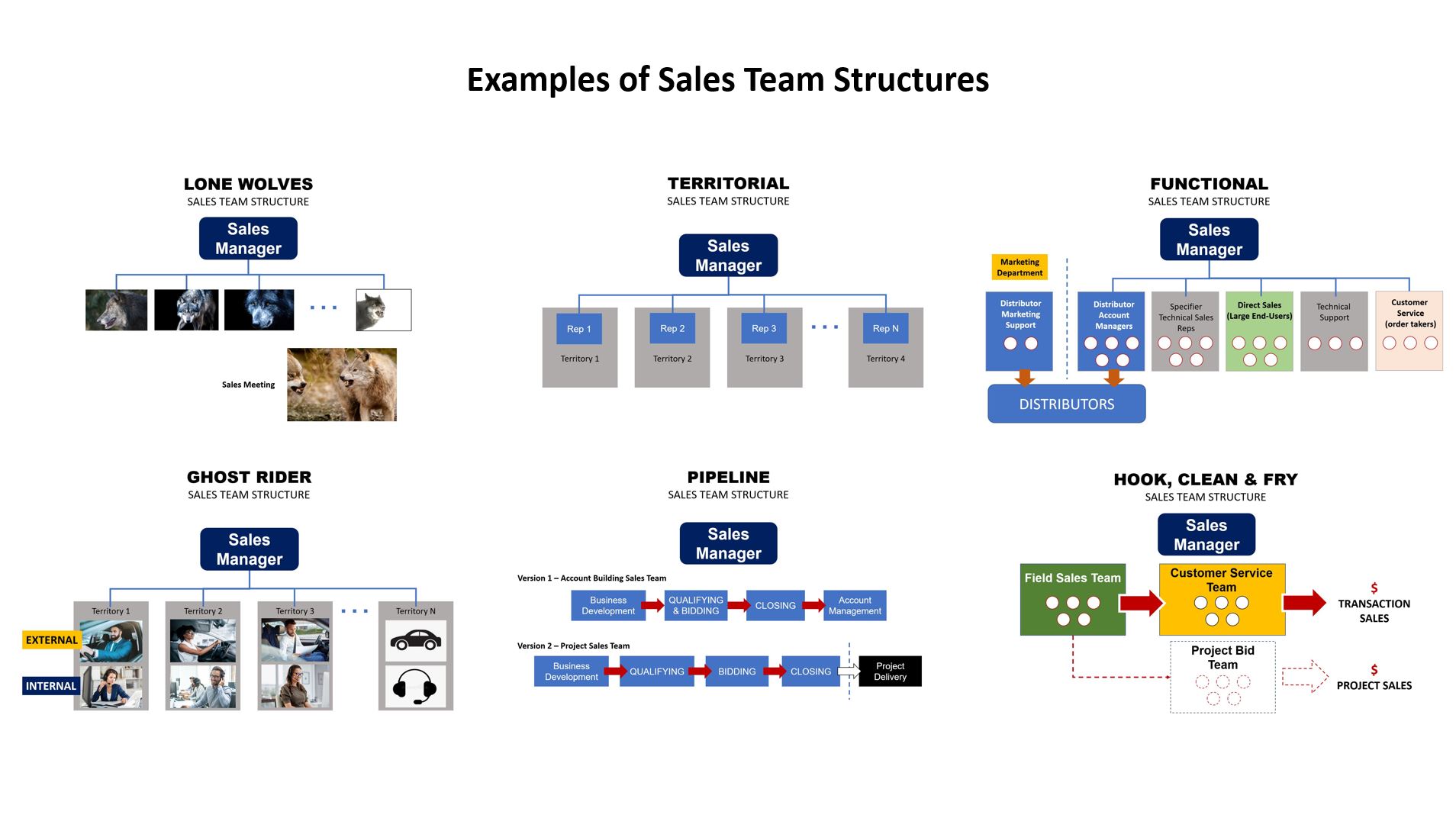
Structure comes from the division of duties (tasks) allocated to specialist roles.
Having identified the sales processes that match the needs of the business, and broken break them down into tasks, the next step is to define the distinct roles needed in the sales department.
For example, the building construction firm will need people to do designing and estimating. The technical product importer will need technical support people, account managers to look after distributors, and a customer service team to take and process sales orders. Smaller businesses may need to combine roles. Larger businesses will seek to create more specialized positions.
For a complete description of each sales organization structure and the types of businesses they are best suited to, see sales organization structures.
Position descriptions - defining the key roles within the sales organization

In order to recruit and train people to fulfill the defined roles in the sales organization structure, best practice is to draft a position description. The position description lists all of the main tasks that each person is expected to perform. It is written based on what needs to be done as defined by the selling model. It is not written based on current team members and what they are good at.
Having defined all the sales tasks required to drive the sales process, these must then be assigned to each role within the sales team.
Depending on the work load there may need to be more than one person in each role. For example, multiple sales representatives each having the same position description but assigned different customers or territories to look after.
Person specification

The position description does not define the attributes required to recruit the best person to fulfill each role. This is achieved by writing a person specification which lists the qualifications, skills, experience, and personal attributes required to perform the tasks and duties comprising each role.
Distinguishing between TASKS and PERSON through having a two step process is a good practice. Blending the two occurs when sales activities and structure are decided based on available personalities. This will create a team that focuses more on the type of tasks they have a preference for rather than what needs to be done as defined by the selling model.
Personality driven sales departments also tend to bias the sales thrust toward the market segments and customer types the current people in the team feel most comfortable with rather than where the greatest market opportunity exists.
This is how inefficiency is built into the sales department structure.
Recruiting the sales team

Combined together, the position description and the person specification are used to draft recruitment advertising and aid in the selection of applicants.
The main question that arises is how many people do we need?
Estimating the size of the sales team - a worked example
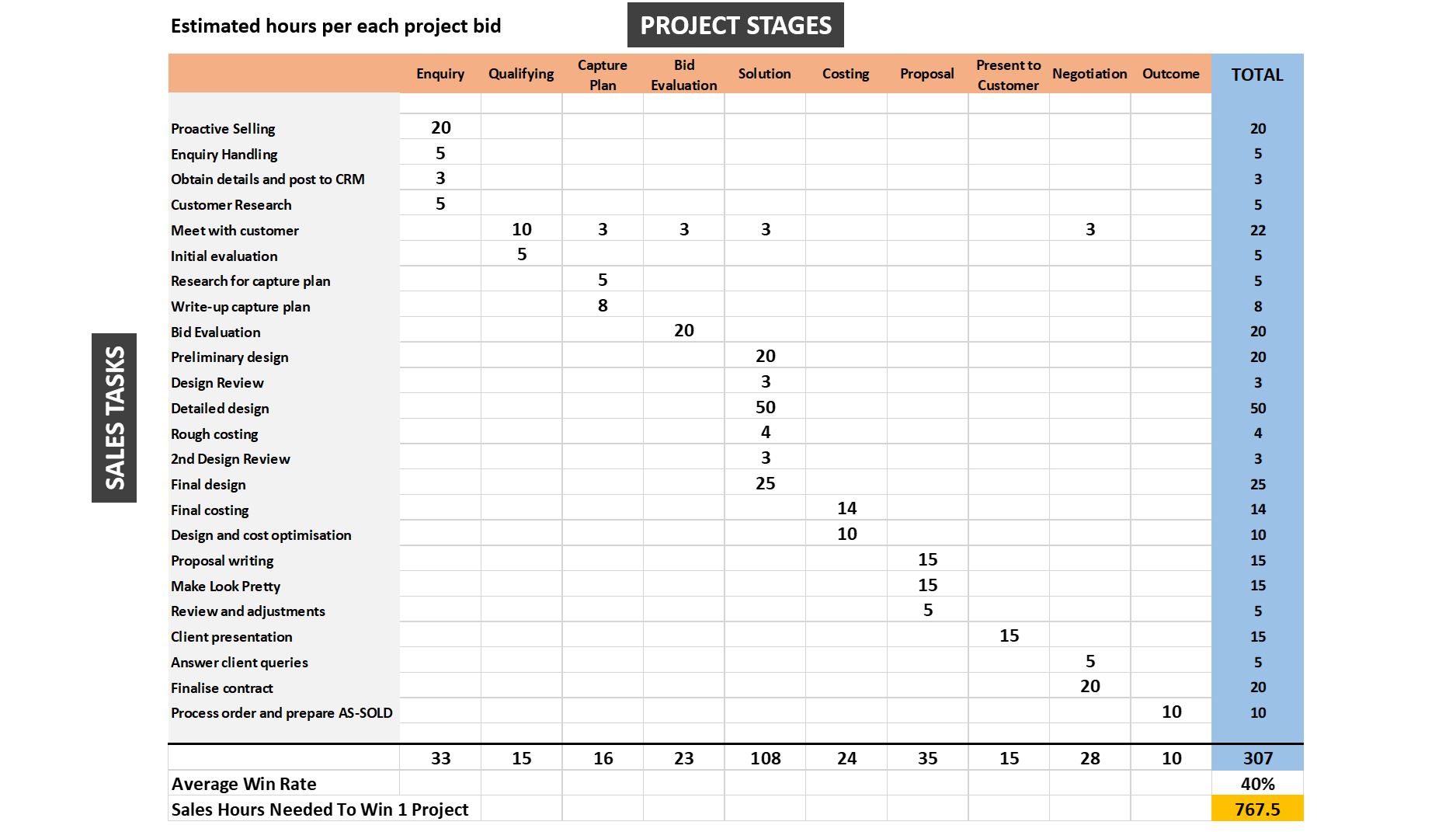
Note: Calculations based on Australian Dollars and market rates as of December 2023.
The above spreadsheet illustrates the broad principal of identifying the Sales Stages and Sales Tasks required to drive the selling model.
This is an example of the predominately "hunter" sales organization. We discuss the "farming" sales organization later.
The example discussed here is an idealized engineering firm where average project value is $2 million and ignores the possibility of also selling consulting, maintenance, service, selling spares or other transaction sales. All of which would increase revenue but requiring additional sales hours. Let's keep it simple to illustrate the principles.
The spreadsheet shows, on average, 307 sales hours are required to close a $2 million sale.
However, the firm's average success rate is 40%, so to achieve each sale actually requires 768 hours.
In other words, 60% of completed and submitted bids are lost to competitors.
Therefore we divide the average time required for each bid (307 hours) by 40% = 768 hours.
Taking into account annual leave, sick days, and public holidays and also allowing for 25% non-selling time (training, internal meetings, and goofing-off) - each sales team member can contribute 1,575 selling hours per year.
Assuming their annual sales target is $40 million (20 completed projects), the above spreadsheet informs us that the estimated total sales team hours required per year will be 768 X 20 = 15,360 hours.
Therefore, a sales team size of 9.75 people is required (15,260 hours divided by 1,575 hours per team member).
Add to this a sales manager and two junior admin people brings the total estimated team size to 12.75 people.
Assuming employment costs of:
- Sales Manager = $175,000 per annum
- Sales Team Members = $120,000 per annum (average)
- PLUS Two admins of $60,000 per annum each.
The total employment cost is $1.465 million or 3.7% of sales.
Adding other sales department costs (training, travel, entertainment, office space, phones, motor vehicles, coffee and biscuits) of (say) $750,000 brings the total sales department cost to $2.2 million or 5.5% of sales.
Using estimated hours to help decide sales department roles
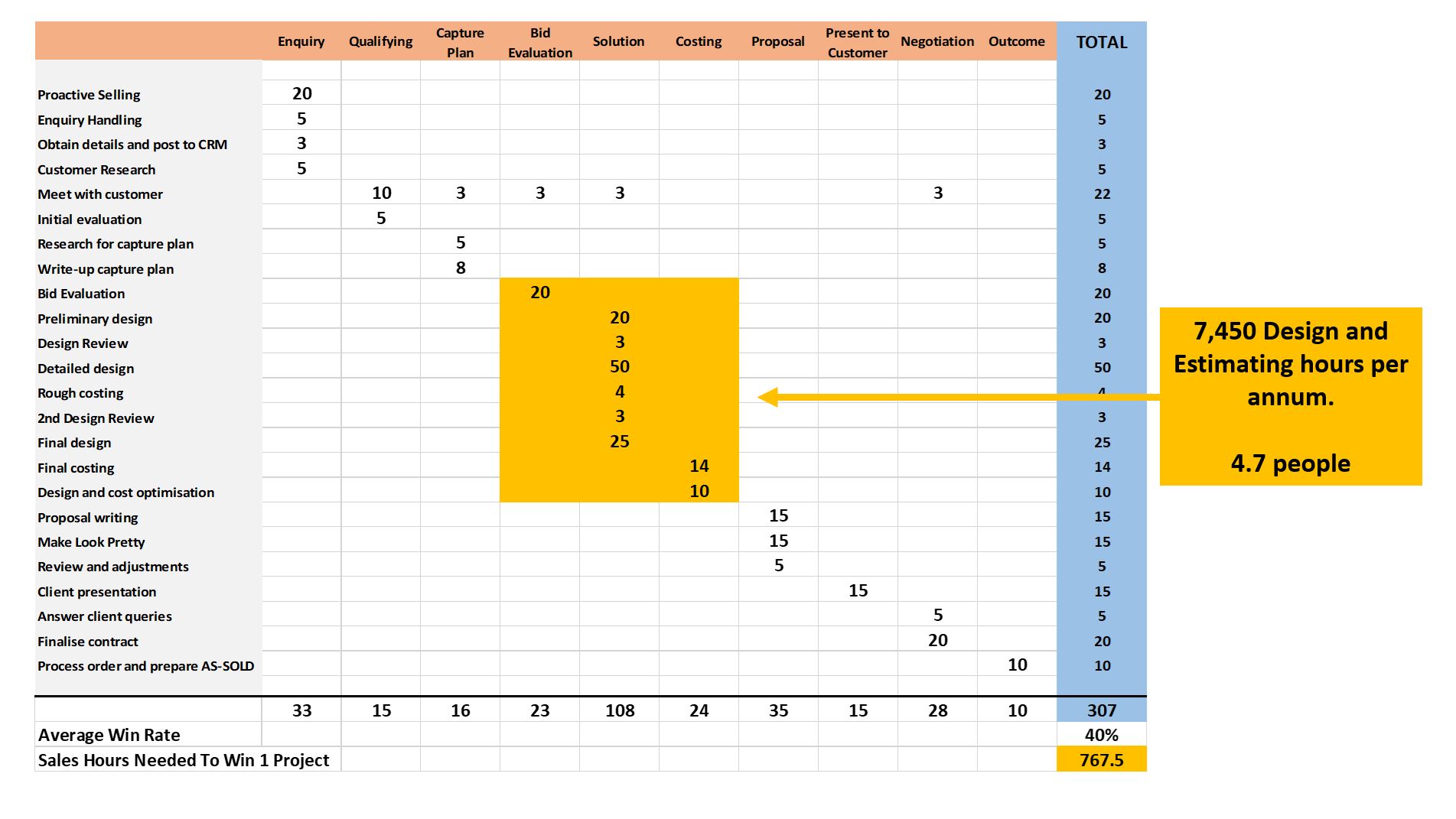
Looking at the spreadsheet we see that there are 7,450 hours of design and estimating work per annum (adding the hours in the gold colored cells totals 149 hours per bid. Divide by 40% and multiply by 20 = 7,450 hours).
This informs us that Design and Estimating is a distinct specialized role in the sales department requiring 4.7 people. The remaining work is predominately sales representative tasks.
This is a fairly typical division of duties within the project engineering firm.
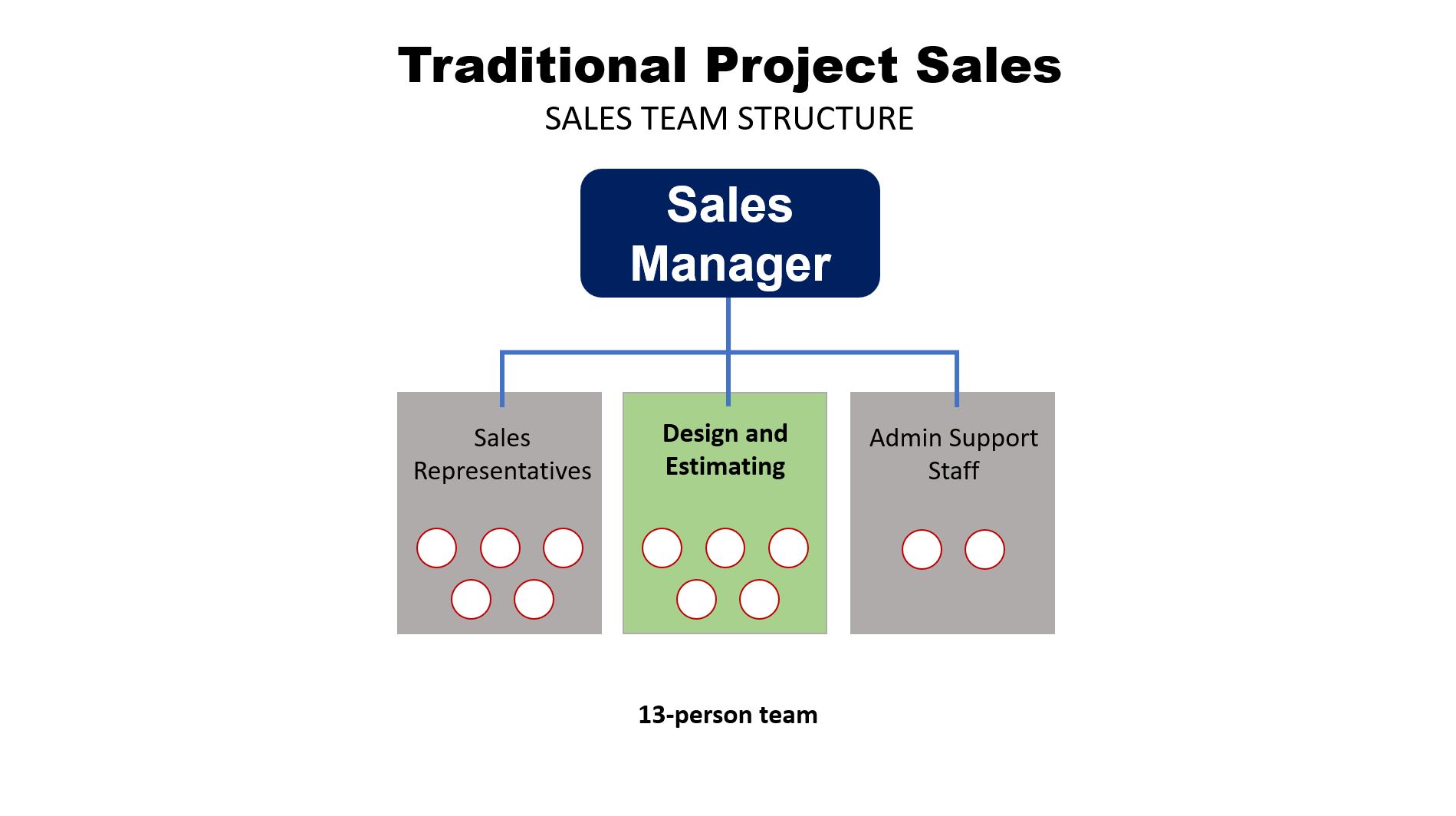
While the above sales team structure (for engineering project sales) is fairly typical, it has some significant draw-backs.
The sales representatives must cover the full length of the sales pipeline from initial project (or customer) opportunity identification right through to sales closing. While achieving significant specialist help from the design and estimating department, they must still work both ends of the sales pipeline to ensure maintaining a consistent flow of new projects. Typically when working to close a sales opportunity it is easy to take your eye off the start of the pipeline.
Similarly, most sales people are not great proposal writers tending to "under-cook" both the writing, attention to detail, and presentation required. Specialist proposal writers vastly improve the product and being focused only on that task (specializing) enables becoming increasingly efficient and effective.
Specialization improves overall sales efficiency and effectiveness.
Using the analysis to develop a more effective and efficient sales team structure
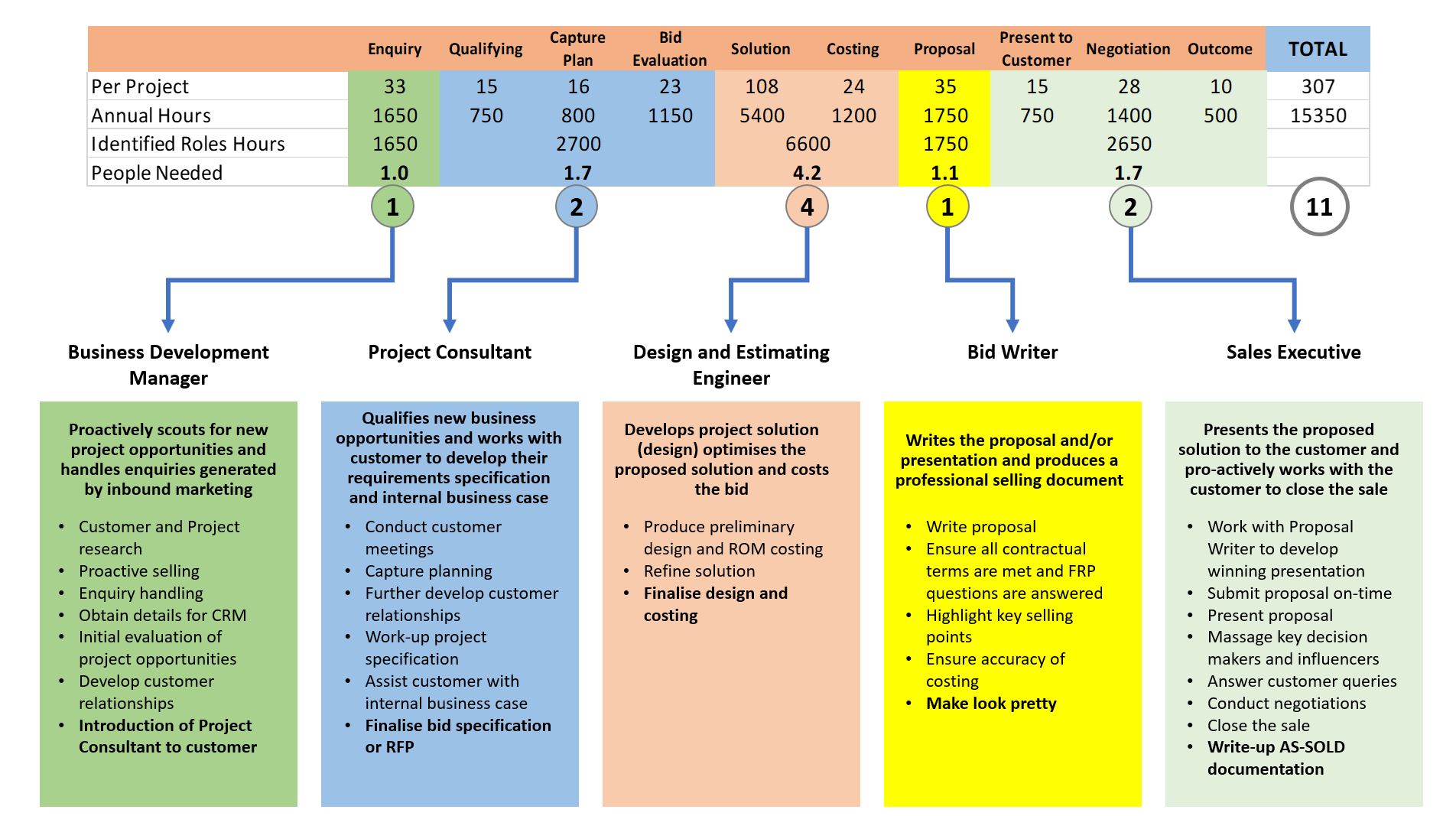
Using the same analysis, we can identify more specialized roles by aggregating the sales stages into distinct roles. Further, by identifying these roles we are able to identify additional tasks that weren't included in the original spreadsheet analysis.
Having put the effort into building the spreadsheet and estimating hours we are to able to address typical management team concerns "Yes, specialization sounds good in theory but is there enough work to keep each person busy?"
This results in the following sales team structure.

We see the improvement. The sales team members now have a more distinct division of duties, roles, and responsibilities.
While other members of the team are focusing on their specialized role they are not being distracted. Thus, while the Sales Executive is dedicating time to closing a sale, the Business Development Manager is actively hunting for other opportunities.
The advantages of specialization are...
- A more consistent flow of project work
- It is easier to find people who have the required qualifications, skills, experience, and personal qualities to succeed in each role.
- Time spent focused on specialized roles develops a much higher level of insight and skill
- When sales team members must cover multiple roles they will tend to either skip important tasks or not give them sufficient attention. Every task has its purpose and must be carried out diligently.
- Overall improved efficiency and effectiveness. Higher project success rate and a greater capacity to pump out new projects.
Farming based sales organization

The worked example above is based on a project sales firm. Many of their clients will be one-offs meaning once the project is delivered the customer is unlikely to buy another. For example, a residential home builder. The predominant activity of the project sales organization is "hunting". Always hunting for new projects.
Let's now look at the firm whose selling activity is predominately "farming".
The name of the game here is to service the customer because they have a need for a regular supply of products.
Examples are:
- Minor equipment and consumable suppliers to mining and construction. Power tools, hand tools, access equipment, safety gear, coatings, chemicals, lubricants, cleaning fluids, fasteners, spare parts.
- Automotive servicing and repair products: panels, spares, moldings, windshields, bearings, gasket kits, suspension components, brake linings, lubricants, transmission fluids, panel repair preparation products (fillers, primers, and aerosols), automotive paint top coats etc.
- Abrasive blasting equipment and consumables: Blast pots, compressors, suits, gloves, helmets, hoses, nozzles, abrasives, safety equipment, and spare parts.
- Automation equipment and components: motors, variable speed drives, sensors and measurement components, PLCs and other controllers, motion sensors, connectors and terminal blocks, power supplies, switches, cables, networking and connectivity components, actuators, valves, racks and cabinets.
There are literally hundreds of product categories both industrial and consumer based. Suppliers that frequently supply to repeat customers typically warehouse significant product inventories ranging from a few hundred SKUs (Standard Stocking Units) to many thousand.
Customer profile for the farming based sales organization and the sales model

B2B organizations that service a customer base that generate regular repeat business typically have a handful of large accounts that generate a significant proportion of overall sales revenue. These are termed "Key Accounts."
The typical customer profile has the following features:
- 20% of customers generate 80% of revenue.
- It's not unusual for the largest customer to be significantly larger than the remaining Key Accounts. This customer is known as the "Anchor Customer". Losing the anchor would have a significant impact on total revenue such that the organization would require significant cost-cutting (downsizing).
Looking at the above diagram (ABCD customer profile), lets explain the various labels...
-
A customers: Typically, 80% of sales revenue will be generated by A and B customers. However, it is not uncommon for 80% to come from only the A customers. The definition of an A customer are those that are critical to the organization. Losing one causes considerable pain. It makes sense to assign your best Account Management people to look after the A customers. Typically, these sales people are called "Key Account Managers". A and B customers typically are on on some form of contract. Usually committing to a minimum sales volume and/or exclusivity arrangement in return for discounted pricing. Negotiating this arrangement and monitoring adherence by both parties to the agreed terms is part of the Account Manager's job description.
-
B customers: As a group, the B customers are also important contributors to sales revenue but losing one can be tolerated without cutting expenses. They are also a prime source of potential future A customers. Both the A and B customer relationships are managed by assigning dedicated sales people. As indicated on the chart 1:1 selling is used. This means each customer has a dedicated sales rep who has sufficient time to meet with their customers face-to-face. Depending on the workload (and profit generated) per account many farmer based sales organizations might have a single key account manager dedicated to one A customer. However, Account Managers generally look after multiple B customers.
-
C customers: are smaller and do not justify having a dedicated account manager (no face-to-face selling). However C customers are still profitable, but the loss of a C-customer isn't immediately noticed. Typically 1 to many sales and marketing techniques are used to service C customers using a combination of eDM marketing (electronic mailing campaigns) and INBOUND and OUTBOUND telesales. Most of the C customers are simply smaller organizations not having sufficient demand for products to become B or A customers. However, usually among the C s are potential A & B customers. They are also buying from competitors to meet their needs. Customers can grow in size. A sales process is needed to monitor and investigate C customers to identify potential A or B customers. Assigning growth potential C customers to an Account Manager (and therefore engaging in face-to-face visits) is the usual method of nurturing C's up the ladder.
-
D customers: termed "rats and mice" the D customers are casual sales, cash-sales etc. they buy one to a few times per year or regularly buy "onsies and twosies" per order. Generally they do not qualify for a 30-day account. The vast majority of "customers" by number are D customers hence the term "the long tail". D customers are problematic. They are usually poor payers (if they have a 30-day account), and ask the most sales-support questions per sale (particularly technical support).
Typically the "Long Tail" D customers contribute 8 to 15% of sales but consume 15 to 30% of sales department time. And that's just the sales department. They have a similar time impact on accounting, credit, and order fulfillment.
Some organizations provide a sales counter at the front of the warehouse to service D customers either providing dedicated front-counter staff but mostly "someone is called to the front counter from the sales department" thus distracting them from higher value work. It is not uncommon for a sales team member to spend 45 minutes at the front counter talking to some bloke trying to decide if the widget is suitable for his hobby project and then leaving "to think about it."
Many B2B sales organizations have done the analysis and realized that D-customers actually cost them money and have shut down their front counters and/or introduce a policy of only selling to customers who can qualify for a strictly monitored 30-day account. Further, they may charge a stiff handling fee for orders below a minimum value. Appointing retail distributors to handle small customers and online sales portals are viable alternatives.
However, occasionally your competitor can't supply their captive A, B or C customer and they call you. You can't assume every D customer is a time waster. A process is needed to identify when this happens.
The Selling Model for the farming sales organization has the following features:
- Account Management is the dominant sales activity: Sales people are assigned to customers typically by customer size. The anchor customer and other Key Accounts are given priority both to protect them from competitors and to maximize revenue
- Seeking new accounts and demand creation using both INBOUND and OUTBOUND marketing
- A process for identifying smaller accounts with potential and developing them into larger accounts
- Promotion (typically email marketing) to create demand from existing customers
- A customer service team to efficiently receive and process sales orders
- Technical product sellers will also provide subject matter experts (technical support) who may also engage in specification selling.
Prioritizing sales process and activities for account management
More to come.
